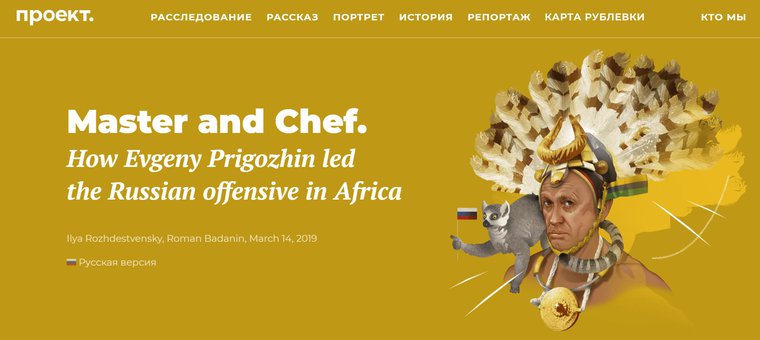Russian indie media needs visibility – that’s why the Pulitzer row matters

Independent journalism in Russia is struggling to survive. Hard hitters like the The New York Times don’t have to do much to lend a hand.
(opendemocracy.net – Roman Badanin – May 14, 2020)
Roman Badanin is editor-in-chief of the investigative media outlet Proekt and former editor-in-chief of TV Rain, one of Russia’s few independent news outlets in Russia. Badanin, who began his journalistic career in 1996 at Izvestiya, has since edited several media projects, such as RBC, Gazeta.ru, and Forbes Russia.
On May 4, 2020, the Pulitzer Prize committee announced its winners for 2019. In the category for “International Reporting” the winner was a group of reporters from the New York Times![]() “for a set of enthralling stories, reported at great risk, exposing the predations of Vladimir Putin’s regime.”
“for a set of enthralling stories, reported at great risk, exposing the predations of Vladimir Putin’s regime.”
One of these winning articles was dedicated to exposing Moscow’s secret dealings in Madagascar and other African states. These are crucially important stories for a U.S. audience – Russia’s operations in Africa are sponsored by Yevgeny Prigozhin, a secretive Russian businessman who’s also known for being Vladimir Putin’s private chef. This is the same Prigozhin who in 2016 oversaw attempts to interfere in U.S. elections. Considering these factors, the NYT’s victory is understandable and well-deserved.
But there’s a nuance.
 To no small degree, the stories published by the NYT in the autumn of 2019 repeat findings published at least six months earlier by the independent Russian investigative outlet Proekt, which I founded a year and a half ago.
To no small degree, the stories published by the NYT in the autumn of 2019 repeat findings published at least six months earlier by the independent Russian investigative outlet Proekt, which I founded a year and a half ago.
A similar incident took place three years ago, when the NYT also won a Pulitzer for articles about Russian hackers which largely repeated the conclusions of two previous investigations by the Russian independent outfit Meduza.
As far as I can tell, the issue in neither case is plagiarism, but rather the NYT’s peculiar policy on referencing. It is a policy which for some reason forbids this paper of world renown to cite regional, foreign, or niche media outlets, even if their reporting had been published months ahead of the NYT. It is not a policy which has gone unquestioned in recent years. Perhaps these two instances are enough of a reason for the NYT’s editors to consider changing their rules.
I can offer what I believe to be an important argument to this discussion, should it take place.
Over the past 20 years, the Russian authorities’ severe restrictions on freedom of speech have become such a commonly known fact that most observers have stopped trying to understand its true meaning and consequences. I’ll try to paint a clearer picture. In the summer of 2018, three Russian journalists were brutally murdered in the Central African Republic. They were the first to try to shed some light on Prigozhin’s activities in Africa. The Russian authorities have yet to conduct a thorough and transparent investigation into their murder.
A few months later, in Moscow, Pyotr Verzilov, publisher of the independent media website MediaZona, was presumably poisoned. MediaZona was conducting an independent investigation of the murder in CAR. This attempted poisoning has still not been independently investigated. In the fall of 2019, my colleagues at Proekt, which by that point had published a four-part series on Prigozhin in Africa, encountered unprecedented abuse – they were followed on the street, there were attempts to hack their emails, and they were repeatedly harassed and smeared by Russian state media.
Needless to say, this all went unnoticed by Russian law enforcement.
These instances are just some of the most egregious examples. But even in less extreme cases, Russian independent media are constantly struggling for survival. For a long time, Russia’s independent press has existed as a de facto ‘samizdat’ – small media, registered abroad, and under constant assault by the authorities. However, as the aforementioned examples with the NYT show, even in these conditions Russian journalists are able to create meaningful content which is at least as competitive with what is produced in massive newsrooms in New York, Washington D.C., or London.
Can a simple hyperlink in a Pulitzer article somehow help Russian independent media? Surprisingly, it can. Here are two essential ways:
Firstly, journalism in Russia is always a question of security. And security is a function of visibility and publicity. Media outlets with international connections or a citation by major international media are more difficult to shut down. Their journalists are more difficult to jail. At a minimum.
Secondly, journalism is always a matter of financial sustainability. And financial sustainability is also a function of visibility and publicity. In today’s Russian media market almost all independent media outlets in one way or another depend on donor funding. Non-profit media, like ProPublica, which also won a Pulitzer in 2020, become successful because of solid reporting, visibility, and publicity. Simple recognition can go a long way in promoting and supporting Russian independent media to donors and in building support from readers.
It’s hard for me to predict the outcome of the NYT’s editorial discussion about the politics of hyperlinks. In fact, I’m not even sure whether it will take place at all. My experience from some years of living in the U.S. and interacting with prominent U.S. journalists as a John S. Knight Journalism Fellow taught me that leading newsrooms of the U.S. have high standards for their editorial practices and are ready to revise those that are outdated.
To their credit, U.S. media have already done this on a number of occasions. This may be a case, however, where such a small detail as a hyperlink would support freedom of the press in my country and in many others.
Article also appeared at opendemocracy.net/en/odr/russian-media-nyt-proekt-pulitzer-controversy/ bearing the following notice:
 This article is published under a Creative Commons Attribution-NonCommercial 4.0 licence. If you have any queries about republishing please contact us. Please check individual images for licensing details.
This article is published under a Creative Commons Attribution-NonCommercial 4.0 licence. If you have any queries about republishing please contact us. Please check individual images for licensing details.
